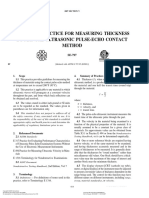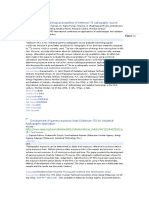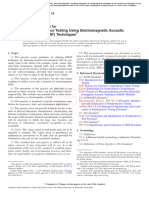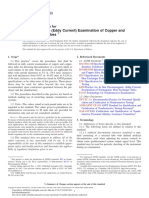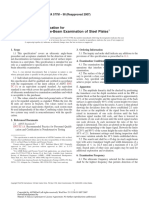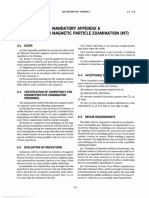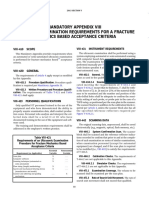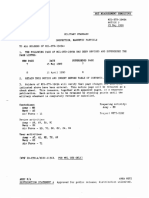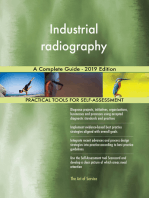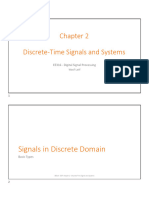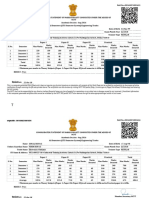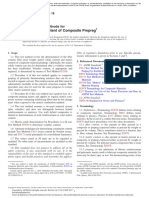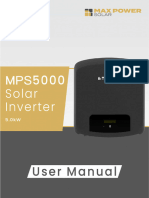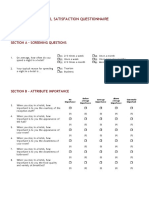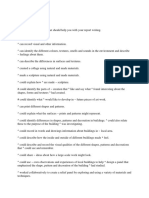Specification For Ultrasonic Inspection of Al-Alloy Plate For Pressure Vessels
Specification For Ultrasonic Inspection of Al-Alloy Plate For Pressure Vessels
Uploaded by
markieboy36Copyright:
Available Formats
Specification For Ultrasonic Inspection of Al-Alloy Plate For Pressure Vessels
Specification For Ultrasonic Inspection of Al-Alloy Plate For Pressure Vessels
Uploaded by
markieboy36Original Description:
Original Title
Copyright
Available Formats
Share this document
Did you find this document useful?
Is this content inappropriate?
Copyright:
Available Formats
Specification For Ultrasonic Inspection of Al-Alloy Plate For Pressure Vessels
Specification For Ultrasonic Inspection of Al-Alloy Plate For Pressure Vessels
Uploaded by
markieboy36Copyright:
Available Formats
SPECIFICATION FOR ULTRASONIC INSPECTION OF
ALUMINUM-ALLOY PLATE FOR PRESSURE VESSELS
SB-548
(Identical with ASTM Specication B 548-90)
1. Scope
1.1 This method covers pulse-echo ultrasonic inspec-
tion of aluminum-alloy plate of thickness equal to or
greater than 0.500 in. (12.7 mm) for use in the fabrica-
tion of pressure vessels. The ultrasonic test is employed
to detect gross internal discontinuities oriented in a
direction parallel to the rolled surface such as cracks,
ruptures, and laminations, and to provide assurance that
only plate that is free form rejectable discontinuities
is accepted for delivery.
1.2 The inspection method and acceptance criteria
included in this standard shall be limited to plate of
the following aluminum alloys: 1060, 1100, 3003, Al-
clad 3003, 3004, Alclad 3004, 5050, 5052, 5083, 5086,
5154, 5254, 5454, 5456, 5652, 6061, and Alclad 6061.
1.3 This method applies only to ultrasonic tests using
pulsed longitudinal waves which are transmitted and
received by a search unit containing either a single
crystal or a combination of electrically interconnected
multiple crystals. Ultrasonic tests employing either the
through-transmission or the angle-beam techniques are
not included.
1.4 This method shall be used when ultrasonic inspec-
tion as prescribed herein is required by the contract,
purchase order, or referenced plate specication.
1.5 The values stated in inch-pound units are the
standard. The SI values in parentheses are for informa-
tion only.
1.6 This standard may involve hazardous materials,
operations, and equipment. This standard does not
purport to address all of the safety problems associated
with its use. It is the responsibility of the user of this
709
standard to establish appropriate safety and health
practices and determine the applicability of regulatory
limitations prior to use.
2. Referenced Documents
2.1 The following documents of the issue in effect
on date of material purchase form a part of this
specication to the extent referenced herein:
2.1 ASTM Standards:
E 114 Practice for Ultrasonic Pulse-Echo Straight-Beam
Examination by the Contact Method
E 214 Practice for Immersed Ultrasonic Examination by
the Reection Method Using Pulsed Longitudinal
Waves
E 317 Practice for Evaluating Performance Characteris-
tics of Ultrasonic Pulse-Echo Testing Systems Without
the Use of Electronic Measurement Instruments
2.1.2 Other Standard:
ASNT Recommended Practice for Nondestructive Test-
ing Personnel Qualication and Certication Ultra-
sonic Testing Method SNT-TC-1A.
3. Summary of Method
3.1 The plate is inspected ultrasonically by scanning
one rolled surface with a beam of pulsed longitudinal
waves which is oriented in a direction perpendicular
to the entry surface of the plate. The ultrasound is
transmitted into the plate either by the direct contact,
immersion, or liquid-column coupling method. During
the scan, an indication representing the rst back reec-
tion is observed on the A-scan screen of the test
instrument.
SB-548 1998 SECTION II
3.2 When the test system sensitivity level is appropri-
ately adjusted, a discontinuity is detected during the
scan by noting an isolated indication associated with
a loss of the rst back reection indication. The apparent
size of the discontinuity is determined by measuring
the total area in the scanned entry surface of the plate
where the isolated indication and the loss of back
reection persist. The estimated discontinuity size and
location are then compared with suitable acceptance
criteria.
NOTE 1 Additional information describing ultrasonic tests by
the direct contact method and by the immersion method is available
in Practices E 114 and E 214.
4. Signicance and Use
4.1 A number of factors such as the condition of
the entry and back surfaces of the plate, the inclination
of the ultrasonic beam with respect to the entry surface,
and the performance characteristics of the test system
may cause either a reduction of isolated indications or
a substantial loss of back reection and thereby could
seriously impair the reliability of the test procedure
outlined in this standard.
4.2 Accurate evaluations of discontinuity size also
may be limited signicantly by variations in beam
characteristics which exist in most search units. For
this reason, discontinuity size as determined by the
test procedure outlined in this method is regarded as
apparent or estimated in recognition of the limited
quantitative value of the measurement.
4.3 Because a large number of interacting variables
in a test system can adversely inuence the results of
an ultrasonic test, the actual quantitative effects of
deteted discontinuities upon the mechanical properties
of the inspected plate are difcult to establish. Conse-
quently, this ultrasonic inspection method is not applica-
ble as an exclusive indicator of the ultimate quality
and performance of pressure vessels but provides a
reliable control of plate quality to avoid failure during
the forming process for fabrication of vessels.
5. Apparatus
5.1 Test Instrument Any electronic device that
produces pulsed longitudinal waves and displays ultra-
sonic reections on an A-scan indicator when used
with an appropriate search unit is satisfactory. The
instrument shall provide stable, linear amplication of
received pulses at a selected test frequency and shall
710
be free from signicant interface signal interference at
the required sensitivity level.
5.2 Search Unit The search unit recommended
for this standard is the at nonfocusing type, and
contains a piezo-electric crystal which generates and
receives longitudinal waves at the rated frequency when
connected to the test instrument through a suitable
coaxial cable. A dual-crystal search unit containing
both a transmitting and a receiving crystal in one
container may be used provided the test instrument
will accommodate two-crystal operation and the re-
sulting pulse-echo test is equivalent to that obtained
with a search unit containing a single-crystal.
5.2.1 The total effective area of the crystal or
combination of crystals in the search unit used for
initial scanning shall not be less than 0.4 in.
2
(2.6 cm
2
)
nor greater than 3.0 in.
2
(19.4 cm
2
).
5.2.2 The effective diameter of the round search
unit used to evaluate discontinuity size shall not exceed
0.75 in. (19 mm).
NOTE 2 For control purposes, the performance characteristics
of the test instrument and search unit may be established in accordance
with procedures outlined in Practice E 317.
5.3 Tank For tests by the immersion method, any
container is satisfactory that will facilitate the accurate,
stable positioning of both the search unit and the plate
to be inspected.
5.4 Scanning Apparatus During the inspection
procedure, the search unit is supported by any one of
the following devices. The scanning apparatus shall
permit measurement of both the scan distance and the
index distance within 0.1 in. ( 2 mm).
5.4.1 Manipulator and Bridge When a manipula-
tor is used in tests by the immersion method, the
manipulator shall adequately support a search tube
containing a search unit and shall provide ne adjust-
ment of angle within 1 deg. in two vertical planes that
are perpendicular to each other. The bridge shall be
of sufcient strength to provide rigid support for the
manipulator and shall allow smooth, accurate positioning
of the search unit. Special search unit supporting xtures
may be used provided they meet the requirements
prescribed for a manipulator and bridge.
5.4.2 Liquid Coupling Nozzle For tests by the
liquid-column coupling method, the nozzle is usually
positioned manually and shall be capable of containing
the couplant while rigidly supporting the search unit
with its active surface immersed in the couplant. The
couplant distance shall be maintained so that the second
PART B NONFERROUS MATERIAL SPECIFICATIONS SB-548
couplant reection is to the right of the rst back
reection on the instrument cathode ray tube (CRT).
The couplant path shall not vary more than
1
4
in.
(6.4 mm) during calibration, initial scanning, and discon-
tinuity evaluation. The recommended minimum inside
dimension of the nozzle is 1.0 in. (25 mm) greater
than the maximum dimension of the crystal surface in
the search unit. Provisions also should be included for
adjustment of search unit inclination within 1 deg. in
two vertical planes that are perpendicular to each other.
NOTE 3 Nozzles containing either sealed or unsealed openings
may be used for inspecting plate provided the test results obtained
with either device are equivalent to those obtained by the immersion
method.
5.4.3 Contact Scanning Unit During tests by
the contact method, the search unit is supported and
positioned manually on the entry surface of the inspected
plate. However, special xtures for contact scanning
may be employed provided their use ensures confor-
mance to the requirements in this specication.
5.5 Couplant Clean, deaerated water at room
temperature is the recommended couplant for tests either
by the immersion method or by the liquid-column
coupling technique. Inhibitors or wetting agents or both
may be used. For tests by the contact method, the
recommended couplant is clean, light-grade oil.
NOTE 4 Other coupling liquids may be employed for inspecting
plate provided their use does not adversely affect test results.
6. Personnel Requirements
6.1 The testing operator performing the ultrasonic
examination prescribed in this standard shall be qualied
and certied to Level I Ultrasonic Testing in accord-
ance with the ASNT Recommended Practice SNT-
TC-1A.
6.2 The required documentation supporting qualica-
tion and certication of ultrasonic testing operators
shall be established by the certifying agency and shall
be available upon request by the purchaser.
7. Condition of Plate
7.1 The entry and back surfaces of the inspected
plate shall be sufciently clean, smooth, and at to
maintain a rst back reection amplitude greater than
50% of the initial standardization amplitude while scan-
ning an area in the plate that does not contain signicant
isolated ultrasonic discontinuities.
7.2 The inspected plate shall be at room temperature
during the test.
711
8. Procedure
8.1 Preferred Method The ultrasonic test may be
performed by either the liquid column coupling, the
direct contact, or the immersion methods. However,
the immersion method is preferred.
8.1.1 Maintain the couplant distance so that the
second couplant reection is to the right of the rst
back reection on the instrument cathode ray tube
(CRT). The couplant path shall not vary more than
4
in. (6.4 mm) during calibration, initial scanning,
and discontinuity evaluation.
8.2 Test Frequency When using any of the three
methods listed in 8.1, the recommended test frequency
is 5.0 MHz. Other test frequencies between 2.0 MHz
and 10.0 MHz may be employed when necessary to
minimize possible adverse effects of plate thickness,
microstructure, and test system characteristics upon test
results and thereby maintain a clean, easily interpreted
A-scan screen pattern throughout the inspection.
8.3 Sensitivity Standardization Standardize the
sensitivity level of the test system operating at the
selected frequency by adjusting the instrument gain
control to obtain a rst back reection amplitude of
75 5% of the vertical limit exhibited by the A-scan
indicator when the search unit is positioned over an
area free from signicant discontinuities in the plate
to be inspected. During test by either the immersion
method or the liquid column coupling method, adjust
the angular alignment of the search unit to obtain a
maximum number of back reections before the nal
sensitivity level is established.
8.4 Scanning With no further adjustments of the
instrument gain controls, locate the search unit over
one corner of the plate to be inspected so that the
edge of the crystal in the search unit is about 1 in.
(25 mm) from either edge of the plate.
8.4.1 Subsequent to checking the angular alignment
of the search unit with respect to the rolled entry
surface to ensure a maximum rst back reection,
proceed to scan the plate continuously by moving the
search unit at a constant scanning rate not exceeding
12 in. (305 mm)/s from the initial starting position to
the opposite edge in a direction perpendicular to the
predominant rolling direction of the plate.
8.4.2 During the scan, note the occurrence of
isolated discontinuity indications and monitor the ampli-
tude of the rst back reection by continuously observ-
ing the A-scan indicator screen.
SB-548 1998 SECTION II
NOTE 5 Auxiliary monitoring devices may be employed in the
test system to enhance detection reliability during the scan.
8.5 Scan Index When the initial scan is completed,
move the search unit over a predetermined scan index
distance in a direction parallel to the predominant
rolling direction of the plate and proceed with a second
scan along a line parallel to the initial scanning direction
while observing the test pattern on the A-scan indicator
screen. Calculate the scan index distance as follows:
Scan index distance (in.), S
i
p 0.8 + D
s
Scan index distance (mm), S
i
p 20 + 0.7 D
s
where:
D
s
p actual crystal diameter.
8.5.1 Continue the inspection by constantly observ-
ing the test pattern on the A-scan indicator while
successively scanning the plate at a constant scanning
rate in a direction perpendicular to the predominant
rolling direction of the plate and indexing the search
unit through the index distance calculated in 8.5.
8.5.2 During the inspection procedure, check the
test system sensitivity standardization periodically by
noting the amplitude the the rst back reection when
the search unit is repositioned over the reference area
of the plate and by adjusting the instrument gain control
as required to maintain the sensitivity standardization
specied previously in 8.3.
8.6 Scanning Rate When the screen pattern on
the A-scan indicator is monitored visually by the test
operator during the inspection, the scanning rate shall
not be greater than 12 in./s.
NOTE 6 Scanning rates greater than 12 in./s may be employed if
auxiliary monitoring apparatus is used to maintain adequate detection
reliability.
8.7 Detection of Discontinuities When an isolated
ultrasonic indication of amplitude greater than 30% of
the A-scan vertical limit is encountered or when the
rst back reection indication decreases to an amplitude
less than 5% of the vertical limit at any time during
the inspection procedure, stop the scan and angulate
the search unit to obtain a maximum isolated indication
and to determine that the loss of back reection is not
caused by misalignment of the search unit with respect
to the plate.
8.7.1 To ensure that the loss of back reection is
not caused by surface interference, check the condition
of both the entry and back surfaces of the plate at the
location where a substantial (95% or greater) loss of
back reection occurs.
712
8.7.2 Either a maximized isolated ultrasonic indica-
tion exhibiting an amplitude greater than 50% of the
amplitude of the initial rst back reection used for
standardization, or a substantial loss of the rst back
reection indication not attributable to either search unit
misalignment or surface interference, is an indication of
an internal discontinuity.
NOTE 7 Isolated indications occurring midway between the entry
surface indication and the rst back reection may cause a second
indication at the location of the rst back reection on the A-scan
screen. When this condition is veried by checking the multiple
back reection pattern, a complete loss of the rst back reection
can be assumed.
8.8 Estimation of Discontinuity Size Note the
location of the search unit where the scan was stopped
when either an isolated indication or a loss of back
reection was observed.
8.8.1 Using a search unit containing a crystal of
effective diameter no greater than 0.75 in. (19 mm),
make an evaluation scan of an entire 6-in. (152 mm)
square area which is centered around the point on the
plate entry surface where the scan was discontinued.
The recommended index distance for this evaluation
is as follows:
S
i
(in. or mm) p 0.7 D
s
,
where:
D
s
pis the actual diameter of the search unit crystal.
8.8.2 To determine the apparent size of the disconti-
nuity, mark each location corresponding to the center
of the search unit on the plate entry surface where a
95 5% loss of rst back reection is observed or
where the isolated indication exhibits an amplitude
equal to 50 5% of the amplitude of the initial rst
back reection established during the standardization
procedure outlined in 8.3.
8.8.3 Continue to mark the location of the search
unit at each point where either or both of the discontinu-
ity conditions specied in paragraph 8.8.2 are observed.
The entire discontinuity shall be outlined even if it
extends beyond the original 6-in. (152-mm) square
evaluation scan area.
8.8.4 The estimated discontinuity size is the area
dened by the boundary consisting of successive marks
as established by this procedure.
NOTE 8 Automatic recording devices may be used to establish
the estimated size of a discontinuity provided the recorded results
are equivalent to those obtained by the procedure presented in 8.8.
PART B NONFERROUS MATERIAL SPECIFICATIONS SB-548
8.9 When the estimated size of a detected discontinu-
ity is determined, return the search unit to the original
stopping position and continue the initial scan to com-
plete the inspection.
9. Acceptance Standards
9.1 Upon completing the inspection procedure, mea-
sure the longest dimension of each marked area repre-
senting a detected discontinuity. Also, when an engi-
neering drawing showing the part to be fabricated from
the plate is supplied, compare the locations of the
discontinuities with the dimensions on the drawing.
9.2 If the longest dimension of the marked area
representing a discontinuity causing a complete loss of
back reection (95% or greater) exceeds 1.0 in. (25
mm), the discontinuity is considered to be signicant
and the plate shall be subject to rejection.
9.3 If the length of the marked area representing a
discontinuity causing an isolated ultrasonic indication
without a complete loss of back reection (95% or
greater) exceeds 3.0 in. (76 mm), the discontinuity is
considered to be signicant and the plate shall be
subject to rejection.
9.4 If each of two marked areas representing two
adjacent discontinuities causing isolated ultrasonic indi-
cations without a complete loss of back reection (95%
or greater) is longer than 1.0 in., and if they are located
within 3.0 in. of each other, the proximity between
the two discontinuities is considered to be signicant,
and the plate shall be subject to rejection.
NOTE 9 A template containing a 1.0-in. diameter hole and a
3.0-in. diameter hole is a convenient device for rapidly establishing
the signicance of discontinuities. If the discontinuities described in
FIG. 1 STAMP FOR IDENTIFYING ACCEPTABLE PLATE
713
9.2 and 9.3 cannot be totally enclosed within either the 1.0-in.
diameter circle or the 3.0-in. diameter circle, respectively, then the
plate containing such discontinuities shall be subject to rejection.
Similarly, if any portions of two adjacent discontinuities greater than
1.0 in. in length as in accordance with 9.4 appear within the 3.0-
in. diameter circle, the plate shall be subject to rejection.
9.5 A plate containing signicant discontinuities of
rejectable size shall be acceptable if it is established
by the purchaser that the discontinuities will be removed
from the plate by machining during the subsequent
fabrication process.
9.6 Upon specic consent of the purchaser, a plate
with signicant discontinuities may be accepted if re-
paired by welding.
10. Report
10.1 When required by the purchaser, a report shall
be prepared and shall include the date of test and a
list of parameters including the type (model number)
of instrument and search unit, the test method, fre-
quency, and the couplant employed for the inspection.
10.2 Preparation of a drawing showing the location
of all signicant discontinuities in the inspected plate
is recommended when the ultimate rejection or accept-
ance of the plate is to be determined by negotiation
between the manufacturer and the purchaser.
10.3 The identication of an acceptable plate is
desirable and is recommended. For this purpose, a
suitable stamp should be employed to indicate confor-
mance to this ultrasonic standard. The recommended
stamp for identifying acceptable plate is shown in Fig. 1.
You might also like
- Ect MAD 8D Calibration Procedure: Using The Vertical Volts MethodDocument7 pagesEct MAD 8D Calibration Procedure: Using The Vertical Volts MethodShanmukhaTeliNo ratings yet
- Reviews of ACFMDocument7 pagesReviews of ACFMNILESHNo ratings yet
- Standard Guide For Radiographic Testing: SE-94 SE-94Document15 pagesStandard Guide For Radiographic Testing: SE-94 SE-94Jhon HernandezNo ratings yet
- Powertrain CAT Part 1Document36 pagesPowertrain CAT Part 1Marius Lakshan ThamelNo ratings yet
- SB 548Document5 pagesSB 548Edson Julio S RNo ratings yet
- E570-97 Flux Leakage Ferro TubularDocument6 pagesE570-97 Flux Leakage Ferro TubularAsif HameedNo ratings yet
- 38DL Plus Ultrasonic Thickness Gage User's ManualDocument308 pages38DL Plus Ultrasonic Thickness Gage User's ManualJake Sparrow100% (3)
- E2096 PDFDocument9 pagesE2096 PDFtingNo ratings yet
- Ultrasonic Testing - Wikipedia PDFDocument26 pagesUltrasonic Testing - Wikipedia PDFKarthicWaitingNo ratings yet
- MT Asme Sec V Article 7Document18 pagesMT Asme Sec V Article 7mohamedNo ratings yet
- AWSD1 1 Procedure UtDocument19 pagesAWSD1 1 Procedure UtGhilman0529No ratings yet
- Asme CC 2541Document1 pageAsme CC 2541ndt_inspectorNo ratings yet
- UT of Pressure Vessel Construction WeldsDocument30 pagesUT of Pressure Vessel Construction WeldsKashif KaziNo ratings yet
- FlexoFORM BrochureDocument4 pagesFlexoFORM BrochureDennis ChaiNo ratings yet
- Phased Array UT Application For Boiler Tube Inspection in Manufacturing Anandamurugan S, Siva Sankar YDocument10 pagesPhased Array UT Application For Boiler Tube Inspection in Manufacturing Anandamurugan S, Siva Sankar YmuhdmsohNo ratings yet
- PMI Positive Material IdentificationDocument2 pagesPMI Positive Material Identificationmahati munnaNo ratings yet
- Se 797Document7 pagesSe 797donaldoguerreroNo ratings yet
- Inspection Report Bifab Ut On Duplex Stainless Steel Piping PDFDocument11 pagesInspection Report Bifab Ut On Duplex Stainless Steel Piping PDFquiron2014No ratings yet
- Ultrasonic Angle-Beam Examination of Steel Plates: Standard Specification ForDocument3 pagesUltrasonic Angle-Beam Examination of Steel Plates: Standard Specification ForSama UmateNo ratings yet
- PressureReliefValves SpecsDocument11 pagesPressureReliefValves SpecsnmosilvaNo ratings yet
- Ultrasonic Test QuestionsDocument6 pagesUltrasonic Test QuestionsMathew Rodriguez75% (4)
- Cal BlocksDocument2 pagesCal BlocksRamy HusseinNo ratings yet
- ASTM E 1104 Measurement of Focal SpotDocument8 pagesASTM E 1104 Measurement of Focal Spotndt_inspectorNo ratings yet
- Procedure Qualification Requirements For Flaw SizingDocument2 pagesProcedure Qualification Requirements For Flaw SizingAngelTinocoNo ratings yet
- Selenium 75Document5 pagesSelenium 75jimmy david espinoza mejiaNo ratings yet
- SD 1186 PDFDocument4 pagesSD 1186 PDFgana_1783No ratings yet
- Asme Sec V A-15-2006Document4 pagesAsme Sec V A-15-2006Muhammed Abo-FandoodNo ratings yet
- Silverwing RMS2 01Document4 pagesSilverwing RMS2 01rubiodegoNo ratings yet
- Plant Integrity Case Study Teletest Focus PlusDocument1 pagePlant Integrity Case Study Teletest Focus PlushcmcrlhoNo ratings yet
- Standard Practice For Measuring Thickness by Manual Ultrasonic Pulse-Echo Contact MethodDocument7 pagesStandard Practice For Measuring Thickness by Manual Ultrasonic Pulse-Echo Contact MethodMauricio FernándezNo ratings yet
- ASME Sec VIII d1 Ma App 8Document2 pagesASME Sec VIII d1 Ma App 8fuihiufhNo ratings yet
- Astm E1962 19Document4 pagesAstm E1962 19Mohamed AboelkhierNo ratings yet
- E243 13 PDFDocument6 pagesE243 13 PDFDaniel Mauricio Prieto ValderramaNo ratings yet
- E1936-97 Evaluating Digitization SystemsDocument4 pagesE1936-97 Evaluating Digitization SystemsNDT Div, MedequipNo ratings yet
- ASTM For Radiographic TestingDocument1 pageASTM For Radiographic TestingMICHAELNo ratings yet
- Saferad ProcedureDocument19 pagesSaferad ProcedureExsan OthmanNo ratings yet
- ASME IX QW Art VDocument2 pagesASME IX QW Art VNacho CajalNo ratings yet
- Eddy Current Examination of Steel Tubular Products Using Magnetic SaturationDocument2 pagesEddy Current Examination of Steel Tubular Products Using Magnetic SaturationChenjie ZhuNo ratings yet
- Ultrasonic Angle-Beam Examination of Steel Plates: Standard Specification ForDocument3 pagesUltrasonic Angle-Beam Examination of Steel Plates: Standard Specification ForJACKELINENo ratings yet
- Form PAUTDocument1 pageForm PAUTLuong Ho VuNo ratings yet
- UT Procedure PDFDocument14 pagesUT Procedure PDFAbhayNo ratings yet
- Astm E2373 E2373m 19Document6 pagesAstm E2373 E2373m 19Mohamed AboelkhierNo ratings yet
- 2013 Asme VIII Acceptance CriteriaDocument8 pages2013 Asme VIII Acceptance CriteriaSiggy LaiNo ratings yet
- Ic Aut 001Document2 pagesIc Aut 001Mohammed Sinan100% (1)
- Ultrasonic Examination Based Acceptance CriteriaDocument2 pagesUltrasonic Examination Based Acceptance CriteriaAngelTinocoNo ratings yet
- Ut Requirements For A Fracture Mechanics Based Acceptance CriteriaDocument2 pagesUt Requirements For A Fracture Mechanics Based Acceptance CriteriaAngelTinocoNo ratings yet
- Vertiscan For Boiler Water Wall Tubes Inspection: How It WorksDocument1 pageVertiscan For Boiler Water Wall Tubes Inspection: How It WorksassurendranNo ratings yet
- Appendix 1 Part 1b Ultrasonic AUT PAUT 5th Edition March 2023Document18 pagesAppendix 1 Part 1b Ultrasonic AUT PAUT 5th Edition March 2023ingM UTNo ratings yet
- LORUS (Onstream)Document2 pagesLORUS (Onstream)ichwanNo ratings yet
- UT - Question and AnswerDocument4 pagesUT - Question and Answerdanish.khan80206040No ratings yet
- Mil-Std-1949a NoticeDocument3 pagesMil-Std-1949a NoticeGökhan ÇiçekNo ratings yet
- Ultrasonic Testing of Tube To Tube SheetDocument6 pagesUltrasonic Testing of Tube To Tube SheetDARSHIL RAJPURANo ratings yet
- Exposure Dist CalculationDocument3 pagesExposure Dist CalculationJayaneela PrawinNo ratings yet
- Procedure of UT-TestDocument2 pagesProcedure of UT-TestJohn ShermanNo ratings yet
- Api StandardDocument2 pagesApi Standardkesavan g100% (1)
- BS 2452 (1954)Document30 pagesBS 2452 (1954)siswou100% (1)
- Bolted Flanged Joint: Flanges, Studs & Gaskets. Recommended Practices for the Assembly of a Bolted Flange Joint.From EverandBolted Flanged Joint: Flanges, Studs & Gaskets. Recommended Practices for the Assembly of a Bolted Flange Joint.No ratings yet
- ASME BPVC Section V (526-530)Document5 pagesASME BPVC Section V (526-530)Reza Elang HangkosoNo ratings yet
- Standard Practice For Ultrasonic Inspection of Metal Pipe and TubingDocument6 pagesStandard Practice For Ultrasonic Inspection of Metal Pipe and TubingakbpbNo ratings yet
- Produksi Dan Efektivitas Motion Graphic Sebagai Media Promosi Zetizen Batam PosDocument17 pagesProduksi Dan Efektivitas Motion Graphic Sebagai Media Promosi Zetizen Batam PosRahmat Zainur FujiantoNo ratings yet
- DSP - Chapter 2 - A - Discrete-Time SignalsDocument14 pagesDSP - Chapter 2 - A - Discrete-Time SignalsMoiz SiddiquiNo ratings yet
- Installation Instructions & Owner's Manual: Electronic Steam Unit - Power Humidifier MODELS S2000 AND S2020Document16 pagesInstallation Instructions & Owner's Manual: Electronic Steam Unit - Power Humidifier MODELS S2000 AND S2020Franklin Ergueta100% (1)
- Master of EducationDocument2 pagesMaster of Educationmy lenovoNo ratings yet
- Chandra Naik ThulasappaDocument4 pagesChandra Naik ThulasappaT. A Raju NaikNo ratings yet
- 03 Planeta Hulk #23Document293 pages03 Planeta Hulk #23Ismael Grünhäuser100% (1)
- D3529.32752 Normas PrepegDocument6 pagesD3529.32752 Normas PrepegJose Trinidad Galindo Gomez50% (2)
- Digital Electronics-Synchronous CountersDocument7 pagesDigital Electronics-Synchronous CountersDivya Munigadapa100% (1)
- Color Usage in UI DesignDocument9 pagesColor Usage in UI DesignFethulmubinNo ratings yet
- Saudi Arabia Expats FeesDocument5 pagesSaudi Arabia Expats FeesMuhammad NaeemNo ratings yet
- Fit Practical FileDocument32 pagesFit Practical FileSunita VarshneyNo ratings yet
- Bank Operations Manager Manufacturing Operations ManagerDocument6 pagesBank Operations Manager Manufacturing Operations ManagerLauren StuartNo ratings yet
- La Redoute Case StudyDocument4 pagesLa Redoute Case StudyChawkiTrabelsiNo ratings yet
- Pub002 031 00 - 0106 PDFDocument4 pagesPub002 031 00 - 0106 PDFgabo mangoNo ratings yet
- Installation of Cisco Secure Acs Remote Agent For WindowsDocument16 pagesInstallation of Cisco Secure Acs Remote Agent For Windowsregis_paduaNo ratings yet
- Robotics and Automation in Agriculture: Present and Future ApplicationsDocument12 pagesRobotics and Automation in Agriculture: Present and Future ApplicationsRJ Karthik KNNo ratings yet
- Chapter 2 - ProtocolDocument4 pagesChapter 2 - ProtocolPathella SudhakarNo ratings yet
- Transportation Energy Data BookDocument429 pagesTransportation Energy Data BookSeyedNo ratings yet
- MPS User Manual Ver3.0AB Oct20Document25 pagesMPS User Manual Ver3.0AB Oct20sheikh hamzaNo ratings yet
- f-22 RaptorDocument3 pagesf-22 RaptorMuhammad Umar IqtidarNo ratings yet
- MCQ Unit-I MVN WorkshopDocument41 pagesMCQ Unit-I MVN WorkshopDino JamesNo ratings yet
- TR Prep Package Brochure CAEDocument44 pagesTR Prep Package Brochure CAEpintua_1No ratings yet
- Exam MATH 3070: LssucDocument4 pagesExam MATH 3070: LssucexamkillerNo ratings yet
- Conference Juice Bar Queries - 10 September 2019Document6 pagesConference Juice Bar Queries - 10 September 2019Ray-Mark VenturaNo ratings yet
- Hotel Satisfaction Questionnaire: Customer N. - Section A - Screening QuestionsDocument2 pagesHotel Satisfaction Questionnaire: Customer N. - Section A - Screening Questionsalda_abazaj8353No ratings yet
- Ammonia SynthesisDocument3 pagesAmmonia SynthesisSrinath ChowdaryNo ratings yet
- 2018 Limelight Networks - The State of Online Gaming 2018 PDFDocument26 pages2018 Limelight Networks - The State of Online Gaming 2018 PDFblitzeroNo ratings yet
- Oil Tank Inspection Checklist Brochure 3.20.07 2 PgsDocument2 pagesOil Tank Inspection Checklist Brochure 3.20.07 2 PgsCharlie MendozaNo ratings yet
- Art CommentsDocument2 pagesArt CommentsmerrufNo ratings yet
















